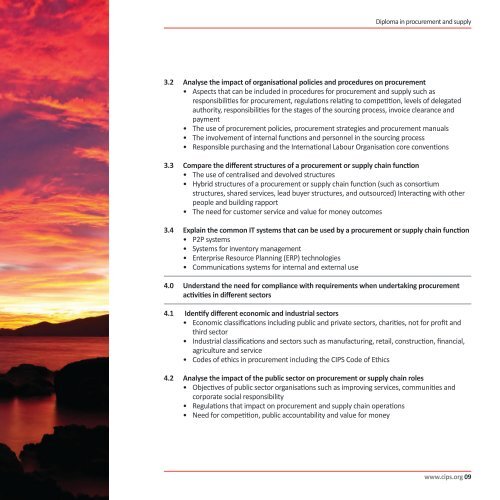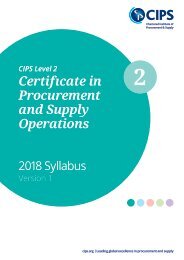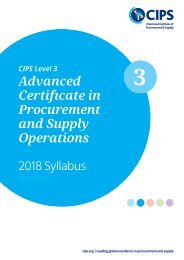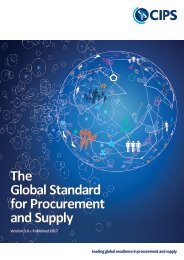CIPS_DipProcSupp_L4_UCG_24pp_210sq_0517_WEB
Create successful ePaper yourself
Turn your PDF publications into a flip-book with our unique Google optimized e-Paper software.
Diploma in procurement and supply<br />
3.2 Analyse the impact of organisational policies and procedures on procurement<br />
• Aspects that can be included in procedures for procurement and supply such as<br />
responsibilities for procurement, regulations relating to competition, levels of delegated<br />
authority, responsibilities for the stages of the sourcing process, invoice clearance and<br />
payment<br />
• The use of procurement policies, procurement strategies and procurement manuals<br />
• The involvement of internal functions and personnel in the sourcing process<br />
• Responsible purchasing and the International Labour Organisation core conventions<br />
3.3 Compare the different structures of a procurement or supply chain function<br />
• The use of centralised and devolved structures<br />
• Hybrid structures of a procurement or supply chain function (such as consortium<br />
structures, shared services, lead buyer structures, and outsourced) Interacting with other<br />
people and building rapport<br />
• The need for customer service and value for money outcomes<br />
3.4 Explain the common IT systems that can be used by a procurement or supply chain function<br />
• P2P systems<br />
• Systems for inventory management<br />
• Enterprise Resource Planning (ERP) technologies<br />
• Communications systems for internal and external use<br />
4.0 Understand the need for compliance with requirements when undertaking procurement<br />
activities in different sectors<br />
4.1 Identify different economic and industrial sectors<br />
• Economic classifications including public and private sectors, charities, not for profit and<br />
third sector<br />
• Industrial classifications and sectors such as manufacturing, retail, construction, financial,<br />
agriculture and service<br />
• Codes of ethics in procurement including the <strong>CIPS</strong> Code of Ethics<br />
4.2 Analyse the impact of the public sector on procurement or supply chain roles<br />
• Objectives of public sector organisations such as improving services, communities and<br />
corporate social responsibility<br />
• Regulations that impact on procurement and supply chain operations<br />
• Need for competition, public accountability and value for money<br />
www.cips.org 09
















